- NEW DVD Series – Stone Setting with Bezels
- Tube Set Charm by Kim St. Jean
- Prong Basket Pendant by Kim St. Jean
- NEW DVD Series – Stone Setting with Cold Connections
- New DVD Series – Stone Setting with Wire
- NEW DVD Series: Introduction to Stone Setting by Kim St. Jean
- Featured Tool: Bracelet Bending Plier
- NEW Dvd by Eva Sherman
- Fun, Fast Fold Forming DVD Series
- Double Band Ear Cuff from Alex Simkin
Gem Profile July 29: Rhodonite
Daily Wire Jewelry Making Tip for
July 29, 2011

Rhodonite
Rhodonite Facts
Rhodonite comes from the Greek "rhodon," which means rosy, and its scientific name is manganese inosilicate. Rhodochrosite, which was last week’s gem, morphs into rhodonite at extremely high temperatures. Because of this, rhodonite is much harder than rhodochrosite. It ranges from a 5.5 to a 6.5 on the Mohs scale and has a specific gravity of 3.5 to 3.7. Black streaks created by manganese oxide run throughout rhodonite. These black streaks rapidly increase when rhodonite is brought to the surface. Like rhodochrosite, rhodonite is very finely grained and commonly occurs in large masses. It has a glassy appearance and is structured much like a prism, with nearly perfect right angles. Rhodonite is pink to rose-red, or it can even be a brownish or brick-red color.Rhodonite History and Sources
Rhodonite is found in several locations. One of these is Franklin, New Jersey. When Franklin was first founded, citizens discovered large, symmetrical pieces of rhodonite that were embedded in calcite (calcite is an extremely common, often fluorescent, white mineral that has a powdery texture and can be easily chipped away). The townspeople also found small, sharply angled pieces with an extremely dark hue. Rhodonite pieces like this have also been found in Congonhas, Brazil. Other rhodonite locations in the United States include Plainfield, Massachusetts and California. Locations around the world include the Minas Gerais in Brazil, and mines in Tanzania, England, Japan, and Siberia. Russia’s Ural Mountains also have large masses of rhodonite that are ideal for carving.
Some of the purest gemstone specimens of rhodonite are located in New South Wales, Australia in the Broken Hill Mines. These rhodonite pieces are embedded in galena, which is the natural mineral form of lead sulfide; lead sulfide is the substance that was once used in pencils before graphite. There are several minerals found with rhodonite at the Broken Hill Mines. Some of these minerals may be confused with rhodonite, because they contain the same materials and have similar coloring. One, pyroxmagnite, is nearly the same as rhodonite. However, this mineral forms at a lower temperature and has a different crystal structure. Bustamite can also be confused with rhodonite, but about 20% of the manganese in rhodonite is replaced with calcium oxide, making bustamite more brown than pink. One way to tell rhodonite from these other minerals is it does not react with acid, and it can also be fused to brown glass easily.
Rhodonite in Culture
In jewelry making, rhodonite is mostly cut into cabochons and beads for use in earrings and cabochons. Many jewelry makers prefer the black-streaked pieces of rhodonite to the plain pink because the streaks give the rhodonite an extra spark of personality. Rhodonite also polishes up very well in a tumbler, so many people buy large pieces of rhodonite to polish and use as paperweights. On very rare occasions, rhodonite can be found as transparent to translucent material that is faceted into gemstones for collectors. Gem cutters must take great care when faceting the stone because it is extremely fragile.
Rhodonite was also once an extremely popular ornamental stone. In the mid-19th century, rhodonite was carved into exquisite table sets, vases, bowls, and tabletops. Rhodonite was also used in 1733 to make the tomb of Alexander II and his wife. A 7 ton slab of rhodonite and jasper form the tomb, which lies in the Peter and Paul Cathedral in St. Petersburg.
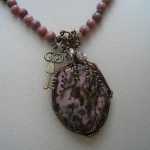
Rhodonite cabochon wrapped with antique brass wire and hung on a necklace of rhodonite and brass beads by Holly Denny
As a healing stone, rhodonite is associated with the heart chakra and is said to bring peace, self-confidence, elegance, gratitude, courtesy and tactfulness, and to help a person to find his or her inner path. Rhodonite is also said to reduce scarring and heal wounds and insect bites, as well as aiding bone growth.
In the coming weeks’ gem profiles, we’ll cover the many types of Jasper. Have you wire wrapped any kind of jasper before? Send pictures to tips@wire-sculpture.com and they could be featured!
Resources
Print Resources:
- Eyewitness Handbooks’ Rocks and Minerals by Chris Pellant, ISBN 1-56458-033-4
- Peterson Field Guide to Rocks and Minerals by Frederick H. Pough, ISBN-0-395-91096-X
- Smithsonian Rock and Gem by Ronald Louis Bonewitz, ISBN 0-7566-0962-3
Internet Resources:
Gem Profile by Wire-Sculpture Staff member Liza Roberts
| Find Rhodonite on Wire-Sculpture.com | |
|---|---|
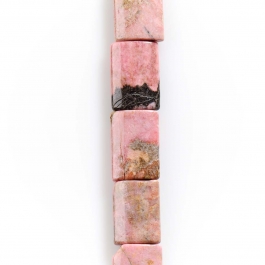 |
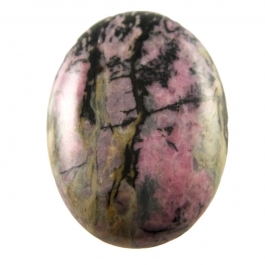 |
| Shop Rhodonite Beads | Shop Rhodonite Cabochons |
Click to Receive Daily Tips by Email





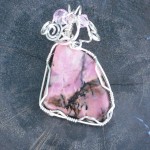
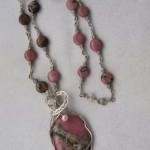
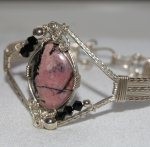
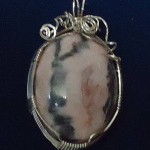
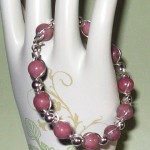















Rusty La Violette
July 29, 2011 at 3:52 pm
We have a stone in our area of north central Washington near the border that people often confuse with Rhodonite; it is Thulite (some times pronounced Thuyoulite ). Can you tell me the difference and how to tell them apart, for sure? Thank you.
Rose
August 5, 2011 at 6:35 pm
Hi Rusty, I’m sorry, I’m not familiar with Thulite. While I think your best bet would be to visit a local Rock & Gem club, I did a little research and here’s what I found: Thulite has a hardness of 6-6.5, which is slightly harder than rhodonite (5.5-6.5). Also, thulite is a form of zoisite, which is a hydrous silicate of calcium and aluminum, whereas rhodonite is a manganese inosilicate. (source: http://www.farlang.com/gemstones/farrington-gems-and-gem-minerals/page_218). I hope that helps!
-WS Staff
Lynn Niehaus
July 29, 2011 at 6:26 pm
Liza,
Very Nice read! I love Rhodonite. I have a small piece, but don’t know what I’m going to do with it yet. Been holding on to it for years, it’s rose/pink with a few small black lines on one corner. Thanks for the article, but do you think it can be found here in florida (without buying it of course) in it’s rough form?
Sincerely,
Lynn Niehaus
Rose
August 5, 2011 at 6:29 pm
Hi Lynn, I’m not sure if you can find rhodonite in Florida. Here is a link to Mindat.org, where you can see that rhodonite has been found in North America, but not recorded in Florida: http://www.mindat.org/min-3407.html However, you’re much closer than we are – you never know! Maybe ask a local Gem & Rock Club, as they would have the best information. Best of luck!
-WS Staff
MERRY PRINGLE
July 29, 2011 at 10:29 pm
I am keeping a record of the gem articles and I just wondered if they could be put where the lettering could be larger and all the info gone from the sides.Thanks
Rose
August 1, 2011 at 11:57 am
Hi Merry, simply select what you want to print (click and hold the mouse button down at the top of the article, then drag the mouse to the bottom of the article), copy the article (Edit > Copy), and paste it (Edit > Paste) into a new Word document. Then you can make the text as big as you like and save it on your computer, or even print it out. Hope that helps!